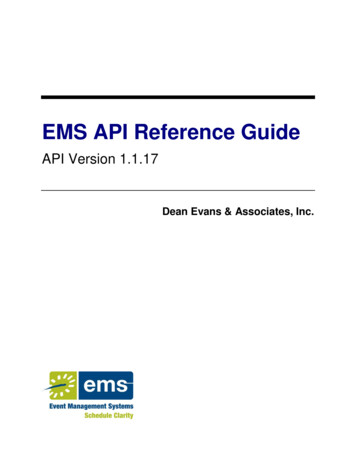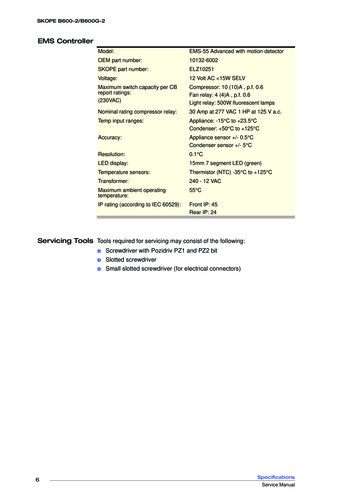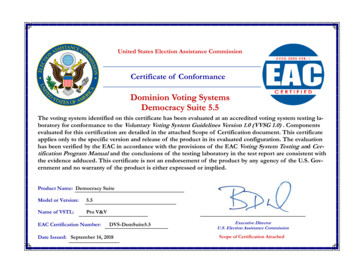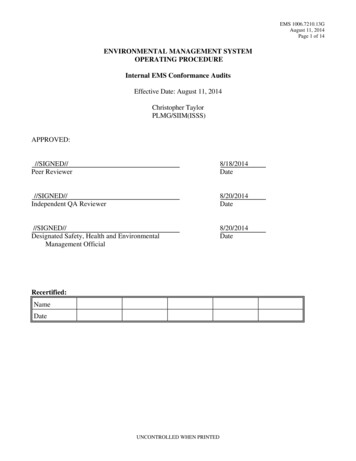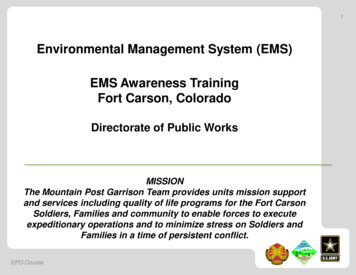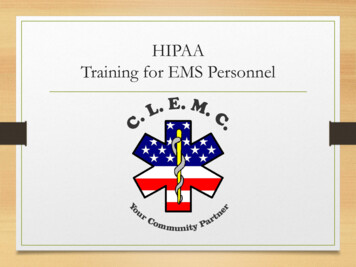
Transcription
HIPAATraining for EMS Personnel
Outline What is HIPAA Components of HIPAA Examples Review
What is HIPAA? “HIPAA” stands for the Health Insurance Portability andAccountability Act of 1996 Passed in the early 1990s to regulate questionable policies andpractices of health maintenance organizations Created privacy practice standards that the healthcare worker mustfollow
“Until now, virtually no federal rules existed to protect theprivacy of health information and guarantee access tosuch information. This final rule establishes, for thefirst time, a set of basic national privacy standards andfair information practices that provides all Americanswith a basic level of protection and peace of mind thatis essential to their final participation in their care.”-Preamble to December 2002 Privacy Rule
Why is it needed? Provides patients with legal rights and voices in howhealthcare groups/companies use the protected healthinformation (PHI) Other areas of HIPAA include “security requirements”for computer storage and transmission of healthcare dataalong with insurance claim "transaction requirements”
Who Must Comply ? Healthcare providers that charge for services includingEMS agencies, Fire Departments, Vol. Rescue Squads &all personnel who work or volunteer for suchgroups/agencies Companies & individuals acting on behalf of suchgroups/agencies, more commonly called “BusinessAssociates”
How does it Impact EMS? Regulations affect how EMS personnel use & transfer pt.information Requires EMS agencies to appoint a “Compliance Officer” &create SOPs for the members to follow HIPAA mandates training of EMS personnel andadministrative support staff
How does it Impact EMS? EMS agencies and personnel must follow HIPAAregulations during pt. care situations, whentransporting pt. information and for administrativefunction EMS agencies must follow HIPAA rules in retaining,managing & releasing patient information/records
How does it Impact EMS? EMS agencies must abide by HIPAA regulations bynotifying patients of their rights in a timely manner EMS agencies must also request that each patientsign a statement acknowledging that he/she is awareof these rights
Violation of HIPAA Civil penalties for violation of HIPAA regulationinclude fines acted without knowing what you were doing was wrong Criminal penalties can include fines and jail knowing what you were doing is wrong and tried to get profit from it Enforcement targets the healthcare provider and agency
Components of HIPAA Using PHI (Definitions) Protecting PHI PHI can be defined as any medical information concerning apatient identification; Name ID number Or any means of identification
Using PHI Because EMS agencies operate in a field setting,HIPAA uses standards of reasonableness to addressprivacy & PHI Generally, patient privacy and PHI become an issue ina pre–hospital setting when loading a patient and accessis not controlled
Using PHI Personnel need to focus on information requestgoing out, not coming in, and who is making the request Generally, other public safety agencies that do notcharge for services are not covered by HIPAA. Theseinclude 911 centers, Fire Departments and LawEnforcements
Using PHI Basic Rules PHI may only be shared for “treatment, payment or operationalneeds” EMS of agencies. Other requests require writtenconsent from patient A “minimum necessary information requirement” is standard forall use of PHI outside of treatment
PHI Basic Rules Treatment includes sharing PHI between; First Responders EMS personnel ER staff Pharmacies and other in kind parties By Voice, Paper Electronic/telecommunication means EMS agencies, Billing companies, guarantors
PHI Basic Rules Healthcare Operations included in sharing of PHI; EMS personnelSupervisorsQA/QIMedical Control PhysicianAdministrative personnelTrainingCase reviewsCISD meetings
PHI Basic Rules If PHI needs to be shared with other public safetygroups, Gov. agencies or other officials in operationalsettings such requests: Must be directly related to a justifiable “need” as permitted byHIPAA regulations
PHI Basic Rules Valid request for PHI include; Mandated Requirements of Law Public Health Activities Abuse/Domestic Situations Health Oversight Activities Judicial & Administrative Law Enforcement Activities
Valid request for PHI (cont.) Deceased PatientsTissue Donation PatientsResearch PurposesThreat to Public SafetySpecialized Government FunctionsWorkers Compensation
Valid request for PHI (cont.) Law Enforcement Process/Covered by Law Identification and Location Victims of Crime Deceased Patients Crime on Premises Reporting Crime
Valid request for PHI (cont.) Generally, “valid” requests for PHI from other publicsafety agencies may be granted keeping “the best interest ofthe patient” in mind In many cases, EMS personnel must use “professionaljudgment” in granting such PHI request PHI must remain confidential for all other requests unless“prior written authorization” has been obtained from thepatient. It cannot be released without written consent
Using PHI – NPP NotificationProcess “Notice of privacy practices” (NPP) includingpatient rights must be provided to each patient at thetime of service or as soon as possible after saidencounter HIPAA regulations give patients specific rightsconcerning PHI and how it is used
Managing PHI - Records Physical SafeguardsLimited accessE-PCRs must meet HIPAA security for electronic PHIPasswords, identification and protocolsRequest for PHI (administrative approval)Dedicated Fax lineE-mailing of PHI (PHI security standards)Made in writingMore information Google 2006 45 CFR 164.500
Case Scenarios Pt. walking across intersection is hit by car at 55MPH. The vehicle was involved in MVA just prior tostriking the pt. EMS, Fire, Police & SPD all have responded Pt has multiple injuries, is unresponsive, open Fxboth legs, with lots of bleeding and vitals aredeteriorating
Case Scenario Fire & Police on scene first Fire starts treating pt. in front of many bystandersthat were helping the victim Did a HIPAA violation occur?
Scenario No – First responders need to treat pt. in theenvironment found, no reasonable measures couldbe taken to assure privacy Ambulance arrives, crew goes to pt. The firstresponder gives a detailed report to the crew in frontof bystanders and Police. Did HIPAA violation occur?
Examples NO – First responders need to give report to the crew The crew loads the pt into the ambulance and startstreating pt. A few minutes later a firefighter brings a priest over thatsays he know the pt. The priest ask about pt condition and ask if the pt isgoing to die? Is this a HIPAA issue?
Example YES – The information request means PHI would be given out.The relationship between pt and priest would have to be verified.Proceed with caution, minimum necessary informationrequirement in place A few minutes later a Police officer brings an obviously upsetwoman to the rig who states that is her son and ask will he liveand what is his condition? Is this a HIPAA issue?
Example Yes -The information request means PHI would begiven OUT. The Police say yes this is his mother,proceed with caution again in what information youshare You leave the scene with pt. You give a radio reportto MC with PHI exchange. Is this a HIPAA issue?
Example No & Yes – PHI is given out, generally pt ID is not givenover radio. If that is needed or requested via MC use a cellphone You arrive at Hospital and you transfer care over to them.While writing your PCR a crew member from anotherdepartment states “WOW” that was a bad one, huh? Did a HIPAA violation occur?
Example Yes – Only crew members directly involved with thecall, supervisors or other administrative personnelshould be reading PCR’s. Police officers on the scene and at the hospitalrequested certain information including pt identityand condition. They are requesting this informationas part of a potential fatality investigation Is it a HIPAA violation to provide this information?
Example NO – LEA Issues In this case of a potentially fatal MVC, providing thePolice with certain information for the investigation isappropriate. This is limited “minimum necessaryinformation requirement”. Several weeks later you are contacted by patients attorney,who wants to talk with you about the incident and ptinjuries. Is it a HIPAA violation to speak with this individual?
Example Possibly – Confirm ID and make sure he hasauthorization as the pt. representative. This is betterhandled with a subpoena for deposition or trial.
Review Understand the concept of PHI and the rules Know when “minimum necessary requirements”should be used Respect the Privacy of the Patient Act in the Best interest of Patients
HIPAA" stands for the Health Insurance Portability and Accountability Act of 1996 Passed in the early 1990s to regulate questionable policies and practices of health maintenance organizations Created privacy practice standards that the healthcare worker must follow
